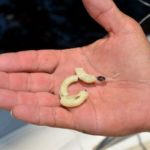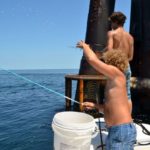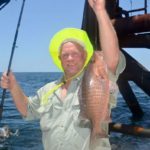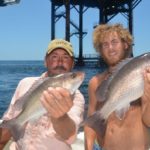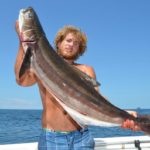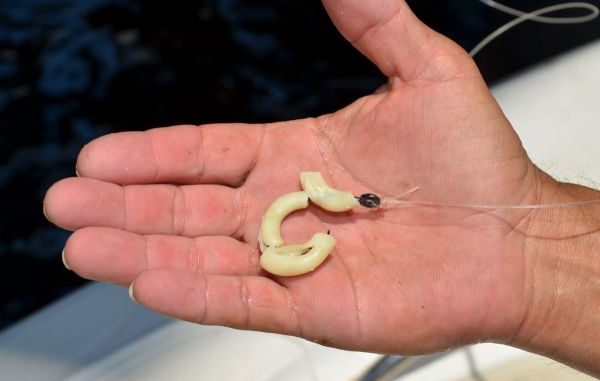
Chumming for mangroves isn’t a secret, but this crew has discovered special recipe the ‘other’ snapper just can’t resist.
The absolutely transparent water churned with fish.
It was like a giant aquarium.
The slightly-built, heavily suntanned 50-year-old man threw another handful of macaroni into the seething mass of Bermuda chubs and mangrove snappers.
Macaroni?
You betcha — macaroni.
I shook my head, just like the first time I had heard about using boiled macaroni as chum to lure mangrove snappers out from under the legs of offshore oil and gas platforms.
The man I heard it from was the same man leading the fishing expedition on this day. David Meyers is the owner and president of Acadian Elevator Inc. in Lafayette, but his real passion is offshore fishing from the Sea Ca Bye, his 32-foot Scarab Sport.
Beginning in late May, Meyers runs 10 or more miles offshore of Grand Isle to chase mangrove snappers and cobia. Sometime later in summer, when Atchafalaya River discharges slacken and offshore waters there clear up, Meyers moves closer to home, launching at Cypremort Point for the minimum 30-mile run offshore.
“You got to have clear water,” he explained.
For the trip that day, Meyers had five others on board: his 23-year-old son Davin and 18-year-old Drake Blanchard, a friend of his son. The other three David described as his “hunting buddies,: Chuck Judice (49) of St. Martinville, Johnny Broussard (48) of Cade, and Cade’s Terry “Tat” Talley (49).
All are Cajuns. The French accent in Judice’s froggy voice was so thick you could have cut it in slabs, like hog head cheese.
All of them were filled with Cajun joie de vivre, the joy of life that makes the race so much fun to be around.
“Watch the youngsters,” David Meyers directed. “They are experienced. The other three don’t know anything about saltwater fishing, although Chuck has made a couple of trips. They will have a good time though.”
As Meyers headed his boat due south into the Gulf of Mexico, he explained that he would be looking for oil and gas rigs in 30 feet of water or deeper.
“I like rigs with living quarters on them because they throw stuff from them,” he said.
The law allows macerated food scraps to be tossed overboard.
“Food scraps is probably how mangrove snappers learned to eat macaroni,” Meyers grinned.
He loaded more than macaroni on the boat to use as actual bait on the hooks, including squid, mullet and pogie for cut bait, and small shrimp in case they stumbled over mahimahi on grass lines.
The night before the trip, the men feasted on boiled crawfish Broussard had caught from the Atchafalaya Basin. On a whim, Meyers withheld some of them from going into the boiling pot — and these he brought on the boat, still alive and kicking.
During the run, Meyers stopped the boat several times to check out small satellite rigs in clear but still green water.
“The water is near clear enough,” he proclaimed.
Meyers kept the boat heading south, and the water became bluer. With the blue water came lines of floating sargassum grass. Using an appropriately thick Cajun accent, Talley promptly dubbed the golden seaweed, “orgasm grass” instead of sargassum grass.
I couldn’t help but laugh. This was going to be a fun trip.
Meyers pulled the boat up to a large platform, and Blanchard hooked up to the platform with a rig hook to secure the boat.
The younger Meyers joined him on the bow, and the pair immediately started tossing handfuls of macaroni into the gin-clear water to sucker mangrove snappers out from the protection of the rig’s legs.
The rods were spooled with either braided or monofilament line. Six-foot, 60-pound-test fluorocarbon leaders with circle hooks were attached to the mainlines with black swivels. The two young men’s preference was for heavy, open-face spinning reels. (David Meyers prefers Ambassador 6000 level wind casting reels.)
Meanwhile, the elder Meyers rigged up the other three anglers with bottom rigs for general bottom-fishing. Broussard and Talley easily adapted to using the Meyerses’ boat rods, but Judice clung to his Zebco spincast rod and reel that he used from freshwater fishing back home.
In one corner, David Meyer set a rod rigged with a heavy jig, a plastic twister tail and a whole mullet. It was ready to go on the short notice, when and if one of them spotted a cobia, an especially prized catch.
Almost immediately, Talley brought up a colorful red snapper. He held it out admiringly.
“Aw,” he cried, “that’s beautiful. I got to throw that back?”
Meyers nodded grimly.
Throughout the day, all three freshwater fishermen, who are used to virtually anything they catch being fair game, showed bafflement with any law requiring good-eating fish that were present in obviously large numbers be returned to the sea.
Up on the bow of the boat, young Meyers and Blanchard had a party going on. The macaroni chum had the water roiling with fish.
On the surface were uncountable numbers of Bermuda chubs. Beneath them were mangrove snappers that were really having to work hard to get any of the pasta.
The anglers kept a regular stream of the bronze-colored beauties coming over the boat’s gunnels. Their usual drill, one well-known by mangrove snapper fishermen all over Louisiana, was to run from the bow of the boat to its stern immediately after hooking a fish.
Mangrove snappers swiftly dive back into the safety of the rig’s barnacle-encrusted legs; running pulled the fish away from line-cutting barnacles much quicker than did standing and reeling.
Even running isn’t fast enough for large, powerful fish, however, the elder Meyers.
“When the fish are big, we won’t hook up to a rig,” he explained. “I’ll run the boat up close to the rig, and when we hook a fish I’ll let it drift back away from it.
“Then I’ll run the boat in to catch another one.”
Judice, wearing an eye-achingly bright chartreuse boonie hat with an international orange band, was watching the fun the youngsters were having.
He laid down his heavy boat rod, picked up his trusty Zebco spincast and moved to the bow to get in on the action.
Immediately, the mangrove snapper bite stopped cold.
“Hey, Chuck,” Talley yelled, “that hat you got flared the fish.”
The whole crew (except Judice) laughed uproariously. Duck hunters all, they knew the rule to avoid bright colors when hunting sharp-eyed waterfowl, which flare before getting into gun range if they spot an unnatural color.
Meyers moved the boat to another rig.
Chumming didn’t produce any fish on top, and nothing was biting on the bottom, either, except for a gorgeous bull croaker Talley hauled in.
“It’s been a long time since I’ve seen a bull croaker like that,” Meyers marveled.
He decided to move, but before the boat was unhooked one of the three hunting friends sang out “big fish!”
“A ling,” Meyers warbled in delight.
But even before he spoke, the youngsters knew what it was.
Blanchard ran down the boat’s gunnel barefooted, like a cat, to get the heavy cobia rod. Beaten to the punch by his buddy, Davin Meyers presented a hunk of cut bait on his lighter spinning rod that he had been using for snapper fishing.
The big brown fish immediately grabbed the bait.
“You will never land that fish on that light tackle,” his father grunted reprovingly.
Out of the blue (literally), a second cobia joined the action.
Blanchard quickly hooked that one on the mullet-rigged jig.
Smaller (15 or so pounds) and on heavier tackle, it quickly came into the boat.
And, to the elder Meyers’ delight, the larger fish was also brought to gaff. It was a solid 30 pounds.
That accomplished, Meyers moved the boat again.
“We will average hitting 10 rigs a day,” he said nonchalantly. “If you don’t see mangrove snappers in the first few minutes at a rig, they aren’t there.
“They are aggressive fish, but they are spooky fish. A loud noise will spook them.”
The next rig was in more than 150 feet of water, and its surface waters swarmed with Bermuda chubs and mangrove snappers ping-ponging off both the macaroni and the cut bait on the men’s hooks.
The current was strong — too strong.
“You want a moderate current,” the senior Meyers explained. “You have to be able to cast up under the rig.”
The current here was so strong it was sucking at the rig’s legs, and a baited hook pitched under the rig was swiftly swept out to the end of the line’s slack.
When that happened, the line tightened and the natural drift of the bait stopped, and the snappers refused to take it.
They caught some mangroves, but nothing like what they should have.
Judice was especially frustrated. He was bound and determined to subdue one with his Zebco, but he couldn’t get his bait to drift right.
“They are in here by the hundreds,” said Meyers, pointing under the rig, “but they are real spooky.”
Then it was like a light bulb lit up in his head. He remembered something.
He moved to the cooler where the live crawfish saved from the boil were stowed. He jabbed one on his hook and tossed it toward the rig.
Bingo — an almost instant hook-up.
Things clicked.
The mangroves were so focused on gobbling up the crawfish that one seldom completed the sweep to the end of the slack line before it was in a snapper’s mouth.
Even Judice finally got in on the action, delightedly proving that his eye-killing hat didn’t spook fish.
After landing one more big cobia and wearing the snappers out for 45 minutes, the wind changed, the current shifted and the snappers disappeared.
The anglers didn’t have their limits yet; that would have taken a prodigious 60 snappers. But they had a big box of fish to clean.
The senior Meyers turned the boat toward home, and the fishermen began to relax for the ride in.
But they weren’t done yet roughing up their 5-foot, 5-inch captain with Cajun humor.
Judice took a long swallow from his canned beverage.
“It always looks like he’s standing in a hole,” he croaked.
Meyers didn’t say anything but turned toward me, his dark eyes acknowledging that he knew more was to come.
“Yeah,” Judice clucked evilly, “that’s why he got radar — he can’t see over the front of the boat.”
This gang still wasn’t taking any prisoners.
Doing macaroni for chumming mangrove snapper
“I was at the Grand Isle Tarpon Rodeo,” David Meyers explained, “when an old timer told me about using macaroni boiled in crab boil for mangrove snapper chum.
“He said, ‘Sometimes it works; sometimes it doesn’t.’ Usually it does.”
Meyer’s preference is for the largest-sized elbow macaroni in the store. The night before this trip, he boiled five 2-pound bags of it with crab boil seasoning and stored it in a covered 5-gallon bucket for the trip offshore.
“Be careful not to overcook your macaroni or it gets super-soft,” he cautioned.
Overcooking makes it difficult to handle (as does allowing it to dry out) and almost impossible to put on a hook. At times, Meyers will use the macaroni for bait, as well as chum.
I asked him why crab boil is added.
He shrugged.
“I don’t know if it would work without the boil seasoning,” Meyers said. “I’ve never tried what the crab boil has to do with it.”
Out on the water the next day, the two Meyerses and Blanchard liberally tossed handfuls of it under and near each rig’s legs.
It was cheap, and they didn’t have to spend time on the messy job of cutting up fish for chum.
Bermuda chum surprisingly tastey
Some fish you never think seriously of eating.
Marsh and bay fishermen feel that way about hardhead catfish. Offshore fishermen think of Bermuda chubs in the same vein.
They are common. Everyone has seen them — kind of clunky-looking and slow-swimming fish. They look like saltwater koi carp with drab longitudinal stripes rather than bright, splashy colors.
Some fishermen know what scientists have documented about the species: It eats porpoise vomit and whale poo.
Yup — that’s right.
It follows ships at sea, too, feasting on garbage the cooks throw overboard.
Knowing all that, I still made up my mind that I had to try them on the table. You never know.
Still — whale poo?
I kept a few from the trip to try them out. Of course, everyone at the fish-cleaning station looked at me as if I had lost my senses.
Worse was what happened when the fillets where cut loose and the contents of their innards was released.
It smell like — well, you know what: Really bad poo. Decayed poo.
Steeling myself, repeating that duty was calling, I rinsed the fillets off thoroughly.
Then came the color. It was just ugly. Not bloody, just ugly — a greenish gray that looked an awful lot like king mackerel meat, not the choicest fish in the sea.
I got ready to fry them with trepidation. I actually worried that it would ruin the 4 gallons of fresh peanut oil in my Pitman Fryer.
The results shocked me. What came out was so different than what went in.
The flesh was tender, flakey and snow white. The taste was incredibly mild and smooth. The texture was perfect.
You gotta try this fish: Just hold your nose when you clean it.
Pulling the trigger on trigger fish
Gray triggerfish are a prized bycatch to red snapper fishing. Their delectable table qualities are evident in their nickname “armored snapper.”
The armor part of the nickname is a tribute to their tough, almost knife-proof skin and scales.
Gray triggerfish have always been part of the suite of fish caught by offshore rig fishermen, but not until a few years ago did they gain the esteem of those who like to eat their catch.
Most knowledgeable fishermen consider them better-eating than snappers.
Just about the time they got popular, federal fisheries managers clamped down on their harvest, to the bafflement of Louisiana anglers. No one was targeting them here, commercially or recreationally, and no one was coming in with ice chests full of the fish.
It turns out that gray triggerfish was following the pattern set first by king mackerel, followed by red snapper and gag grouper.
They are overfished off of Florida, and because scientist can’t find a genetic difference between the fish off of Florida and the fish off of Louisiana, they step on everyone’s heads — even those who didn’t cause the problem and those who don’t have a problem.
That approach and the now-preferred method of management using absolutely rigid yearly harvest quotas are the product of special-interest environmental groups, who policy-wise have become the tail that wags the dog.
The dog, of course, is the combination of commercial and recreational fishermen who for years were the only players in the game of who gets what fish.
In a climate in which overfishing of any species is viewed as a doomsday scenario, fisheries scientists set quotas at the most conservative (meaning lowest) levels that can be considered.
Federal fisheries policy makers, under threat of lawsuit from environmental as well as commercial and recreational interests, are jammed into a corner from which there is no maneuverability to allow people to keep fishing.
The very same gray triggerfish that anglers like the Meyerses and their guests kept last year for consumption must now be dumped back into the water.
Under the miserably low gray triggerfish quota, the feds determined that Gulf of Mexico recreational fishermen harvested more than their limits of the species in both 2013 and 2014.
Those overharvests (totally in other states, of course) now have to be made up in 2015. The result is an almost 11-month closed season, from Feb. 7 through December 31.
A normal closed season is June 1 through July 31.
